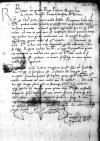Reverendo in Christo Patri, domino ⌊Ioanni Dantisco⌋, episcopo Varmiensi, sincere nobis dilecto
⌊Bona⌋ Dei gratia rex ⌊Poloniae⌋, magna dux ⌊Lituaniae⌋, ⌊Russiae⌋, ⌊Prussiae⌋, ⌊Masoviae⌋ etc. domina
Accepimus ⌊⌋ Vestrae Paternitatis, quibus nobis salutem et prosperam ac florentem valetudinem precatur, et simul gratias agit nobis pro eo, quod Paternitatem Vestram ad eum, in quo nunc est constituta, statum promoverimus. Quae quidem tam gratae voluntatis vestrae de accepto beneficio significatio grata nobis est et accepta.
Speramus, quod Vestra Paternitas in hoc tam alto dignitatis gradu collocata, ita se erga ⌊regias ambas maietatates⌋ et erga ⌊rempublicam⌋ geret, ut malevolos ac invidos eius, quos ait Paternitas Vestra male de se vaticinatos esse, pudeat et vanos falsosque in eorum opinionibus fuisse appareat.
Scimus Paternitatem Vestram habere imaginem serenissimae filiae nostrae ⌊Isabellae⌋. Ea imago, si semiplena est et similis illi imagini, quae a capite secundum pectus est depicta, quam apud nos pictor Vestrae Paternitatis vidit, volumus, ut eam nobis Vestra Paternitas mittat. Sin autem haec ipsa imago plena est et staturam plenam in se continet, estque similis illi imagini, quam pictor Vestrae Paternitatis istic exsistens depinxit, quia turpis est nec omnino speciem formamque ⌊filiae nostrae⌋ refert, eam non cupimus habere. Itaque Paternitas Vestra non hanc, sed semiplenam imaginem ad nos mittat et valeat feliciter.

